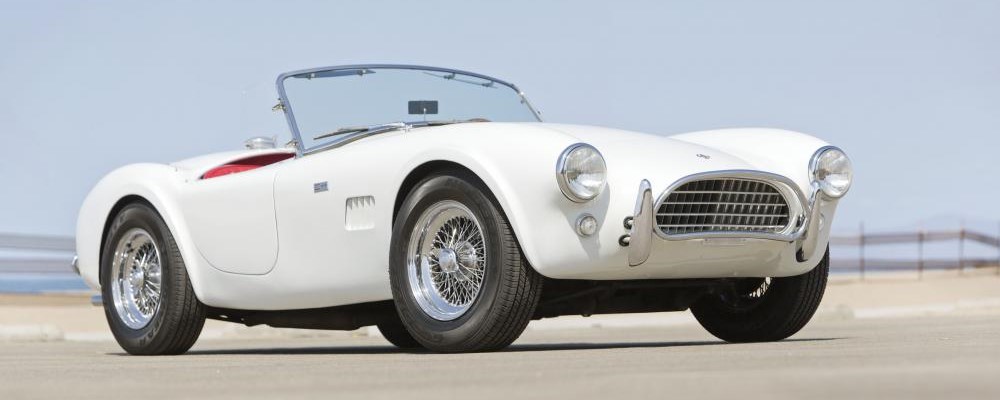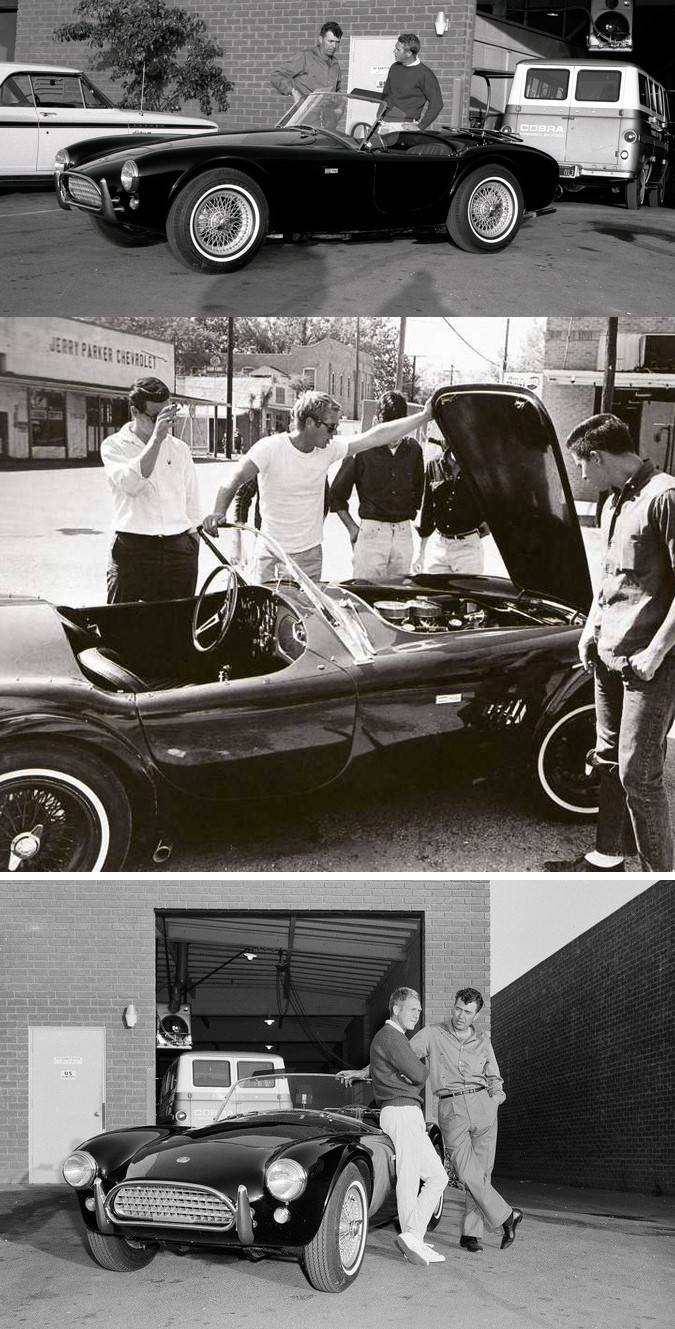Over the next year, AC Cars pressed on with its usual production schedule until a historic moment happened in 1961 when Carroll Shelby entered into negotiations with AC Cars. Backed by Ford, Shelby proposed the installation of a large 4.2-liter V8 in the current lightweight AC Ace. Built by AC Cars, the fusion of brute American horsepower and British aesthetics resulted in the AC Cobra, one of the fastest and most brutal sports car of all times.
By 1963, production of the hand built aluminum-bodied car had reached 15 per week. The AC Cobra also earned a seventh overall finish at Le Mans with a team managed by Sterling Moss. As the months rolled on, AC began gaining momentum due to American innovation and moved beyond the MK1 260 cubic inch 4.2-liter engine, through the 289 4.6-liter American V8, to the immense and legendary 427 S/C (Street Competition) 7.0-liter V8. The jump in horsepower forced AC to develop larger 4″ diameter chassis tubes to handle the incredible torque of the monstrous 500hp V8. At the time, the Guinness Book of Records listed the 427 AC Cobra as the fastest production car in the world, a distinction it held for many years.

The original Shelby Cobra, CSX 2000 marked the start of Carroll Shelby’s incredible automotive legacy. The car was born in 1962 in a small garage in Santa Fe Springs, California, after Carroll Shelby, joined by a handful of hot-rodders, shoehorned Ford’s new, lightweight, high revving 260-cubic inch V-8 into a modified AC Ace chassis. The result—a fierce sports car armed with incredible performance in a lithe, stylish package—became the cornerstone on which the great Carroll Shelby set the world on fire and forever changed the course of automotive history.
CSX 2000 played a multitude of roles during its early days. As the only one of its kind, it was not only used in testing and development, but also driven by the motoring press, and shown in cities across the U.S. to drum up interest and sales for the fledgling company, Shelby American, Inc. During this time, thanks to clever marketing, Shelby also convinced the public that Cobra production was in full swing; the car was repainted a different color for almost every appearance to give the impression that Shelby had more than one car in their inventory. In reality, it remained the first and only Cobra for seven months. CSX 2000’s technical specifications were also extraordinary. A 1962 road test by Road & Track revealed a 0–60 mph sprint in just 4.2 seconds, a standing quarter-mile run in 13.8 seconds at 112 mph, and a top speed of 153 mph.
Throughout its life, even after Cobra production ended, CSX 2000 never shied away from public view, nor did it change ownership. It has been featured in countless books and magazines, continually driven and critiqued in road tests, and a frequent motor show starlet. It was even used for a period of time by employees at the Carroll Shelby School of High Performance Driving.

1964 Shelby 289 Cobra
- 289-cid, 271-hp Ford OHV V-8 engine
- Rare C-4 automatic transmission (less than 20 produced)
- Numerous factory accessories
- Chrome wire wheels
- Factory Demonstrator
- CSX2561; Sold for $825,000 on Saturday, August 3, 2013 by Auctions America
The notion of producing a hybrid sports car in the 1960s was, at its core, quite simple. While British manufacturers retained the edge in styling, road holding and superb braking, American firms held a distinct horsepower advantage. This “best of both worlds” concept was, of course, nothing new. Post-war Allards, Cunninghams, and Nash-Healeys used the same basic premise. Carroll Shelby, however, considered chassis’ from Austin-Healey, Jensen and Bristol before settling on AC, after hearing that the builders of the stylish and sturdy Ace had lost their engine supplier when Bristol ceased production.
Attractive, lightweight and proven, the AC Ace could, by Shelby’s thinking, be turned into a successful production racer by replacing its aging six-cylinder engine with a powerful, deep-breathing V-8. In September 1961, Shelby wrote Charles Hurlock, of AC Cars, to propose a hybrid car using the AC sports car body and chassis. “I’m interested,” wrote Hurlock, “if a suitable V-8 could be found.” Shelby moved quickly when Editor Ray Brock, of Hot Rod magazine, told him of Ford’s new, lightweight small-block V-8. Soon after, Shelby had an early 221-cubic inch example installed in a stock AC Ace. In fact, the V-8 weighed just slightly more than the six-cylinder Bristol.
Ford engineer Dave Evans then offered Shelby an even better solution. A high-performance 260-cubic inch small-block V-8 was already in production for Ford’s Falcon, and two engines would be on the way to him soon. They were immediately sent by airfreight overseas, and on February 1, 1962, Carroll Shelby flew to England to test drive the new Shelby “Cobra.” The rest, as they say, is history.
According to the World Registry of Cobras & GT40s; the 1964 Shelby Cobra 289, CSX2561, was originally billed to Shelby American on August 25, 1964 and was shipped to Los Angeles aboard the SS Alblasserdyk. It was initially used as a demonstrator at Shelby American and was then invoiced to Hayward Ford Motors, of Hayward, California on January 27, 1965. At the time it was originally painted white with a red interior, just as it is currently presented here today. The Registry also states that CSX2561 came with an uncommon C-4 automatic transmission and was sold at a “Factory Demonstrator” price of $5,250.
The first owner of 2561 was Edwin Ovilice, of Oakland, California. By the early 1970s, the car was owned by Jim McCarthy, also from Oakland. The Cobra was later offered by Norm Sinai of Hayward in late 1980. A gentleman named Mr. Cole from California bought the car and then sold it circa 1982 to Donald Mansker of Houston, Texas. Jim Yancey of Paris, Texas next bought 2561in 1983. By this time the car had been fit with a chrome rollbar and had blue interior (both have since been removed and returned to original specifications). The Cobra was next seen being advertised for sale in spring of 1990, then later in 1992 was offered by an auction house. In 1993, the car reappeared in the classifieds and was sold later in the year to Guy C. Eavers from Staunton, Virginia. It is last mentioned in the aforementioned Shelby Registry as being for sale in the December 1996 duPont Registry as completely and immaculately restored with an unwrecked aluminum body, 38,950 miles and the rollbar removed and the interior color returned to its proper red leather.
This example is a standout among its peers. The factory C-4 automatic transmission is quite rare, records indicate that less than 20 examples were sold in this configuration. Ford Mustang floor-shift mechanisms were utilized, as seen in this car. Finished in white with red leather upholstery and red carpet, CSX2561 rides on chromed wire wheels and is shod with Goodyear Integrity tires. It is also equipped with factory accessories that include a soft-top, a spare wire wheel, front grille guard and rear bumper, chrome air cleaner, aluminum Cobra valve covers, adjustable wind-wings, tinted sun visors, competition seat belts, chrome exhaust pipe tips and an outside rearview mirror. Most impressively, this Cobra leaves you with many favorable driving impressions. It is quick, comfortable, tight, and drives very well – all one wants in such a high-performance machine.
The overall fit and finish of the body, paint, upholstery and engine bay is outstanding, with nothing overlooked. There are no blemishes of note on the paint, and the interior is stunning with its black dash and Stewart Warner gauges. Outstandingly presented, CSX2561 is certainly worthy of serious inclusion in the collection of discerning aficionados of post-war American muscle.


Steve McQueen, who was best known for driving a Ford Mustang during the action-packed car chase scene in Bullit, was a fan of the Shelby Cobra. He visited Carroll Shelby at his Venice, Calif. facility throughout the 1960s, though legend has it that studio contracts prohibited him from owning one of the fast roadsters. That did not keep him from sampling the Cobra as Shelby lent him the CSX2174 to cruise around Southern California.

You must be logged in to post a comment.